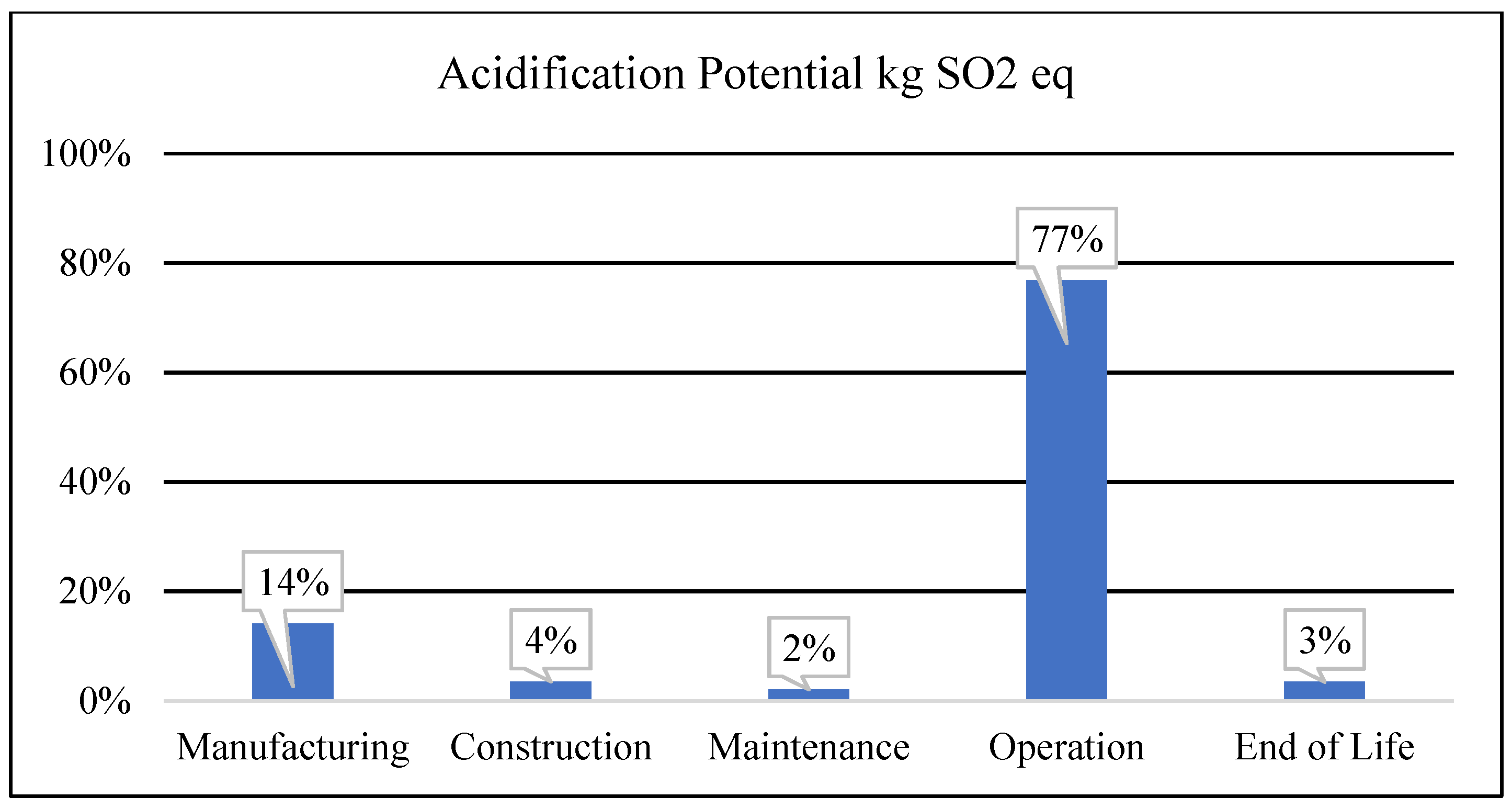Environmental Profiling of Green Educational Building Using Life Cycle Assessment †
Abstract
:1. Introduction
2. Methodology
3. Results and Discussion
3.1. Absolute Environmental Impact Values
3.2. Environmental Impacts over the Life Cycle Phases
Data Availability Statement
References
- Ripple, W.J.; Wolf, C.; Newsome, T.M.; Gregg, J.W.; Lonten, T.M.; Palomo, I.; Eikelboom, J.A.J.; Law, B.E.; Huq, S.; Duffy, P.B.; et al. World Scientists’ Warning of a Climate Emergency 2021. Bioscience 2021. [Google Scholar] [CrossRef]
- IEA. Global Status Report for Buildings and Construction. 2019. Available online: https://www.iea.org/reports/global-status-report-for-buildings-and-construction-2019 (accessed on 10 July 2021).
- Board of Investment Prime Minister Office. Pakistan: Housing and Construction. Available online: https://invest.gov.pk/housing-and-construction (accessed on 30 July 2021).
- Government of Pakistan. Chapter 14: Energy (Pakistan Economic Survey 2019–20); LR Lloyd’s Regist: Government of Pakistan: Islamabad, Pakistan, 2020; Volume 100, pp. 1–35. [Google Scholar]
- Carson, R. Silent Spring; Houghton Mifflin: Boston, MA, USA, 1962. [Google Scholar]
- Ehrlich, P.R. The Population Bomb; Ballantine Books: New York, NY, USA, 1971. [Google Scholar]
- ISO (International Organization for Standardization). Environmental Management-Life Cycle Assessment-Principles and Framework (ISO 14040:1997). Environ. Manag. Syst. Requir. 1997, 44, 12. [Google Scholar]




| LCA Measure | Unit | Manufacturing | Construction | Maintenance | Operational | End of Life |
|---|---|---|---|---|---|---|
| Global Warming Potential | kg CO2 eq | 1.49 × 106 | 1.74 × 105 | 9.39 × 104 | 1.04 × 107 | 1.02 × 105 |
| Acidification Potential | kg SO2 eq | 5.14 × 103 | 1.28 × 103 | 7.56 × 102 | 2.80 × 104 | 1.27 × 103 |
| HH Particulate | kg PM2.5 eq | 2.30 × 103 | 9.89 × 101 | 5.46 × 101 | 3.18 × 104 | 6.51 × 101 |
| Eutrophication Potential | kg N eq | 1.30 × 103 | 1.30 × 102 | 1.95 × 101 | 9.72 × 103 | 7.89 × 101 |
| Ozone Depletion Potential | kg CFC-11 eq | 2.85 × 103 | 1.42 × 10−3 | 2.83 × 10−3 | 8.99 × 10−1 | 4.27 × 10−6 |
| Smog Potential | kg O3 eq | 8.32 × 103 | 3.78 × 104 | 6.05 × 103 | 2.26 × 105 | 4.15 × 104 |
| Total Primary Energy | MJ | 1.37 × 107 | 2.07 × 106 | 1.03 × 106 | 1.80 × 108 | 1.50 × 108 |
Publisher’s Note: MDPI stays neutral with regard to jurisdictional claims in published maps and institutional affiliations. |
© 2021 by the authors. Licensee MDPI, Basel, Switzerland. This article is an open access article distributed under the terms and conditions of the Creative Commons Attribution (CC BY) license (https://creativecommons.org/licenses/by/4.0/).
Share and Cite
Farooq, T.B.; Sajid, M.B. Environmental Profiling of Green Educational Building Using Life Cycle Assessment. Eng. Proc. 2021, 12, 10. https://doi.org/10.3390/engproc2021012010
Farooq TB, Sajid MB. Environmental Profiling of Green Educational Building Using Life Cycle Assessment. Engineering Proceedings. 2021; 12(1):10. https://doi.org/10.3390/engproc2021012010
Chicago/Turabian StyleFarooq, Talha Bin, and Muhammad Bilal Sajid. 2021. "Environmental Profiling of Green Educational Building Using Life Cycle Assessment" Engineering Proceedings 12, no. 1: 10. https://doi.org/10.3390/engproc2021012010
APA StyleFarooq, T. B., & Sajid, M. B. (2021). Environmental Profiling of Green Educational Building Using Life Cycle Assessment. Engineering Proceedings, 12(1), 10. https://doi.org/10.3390/engproc2021012010






